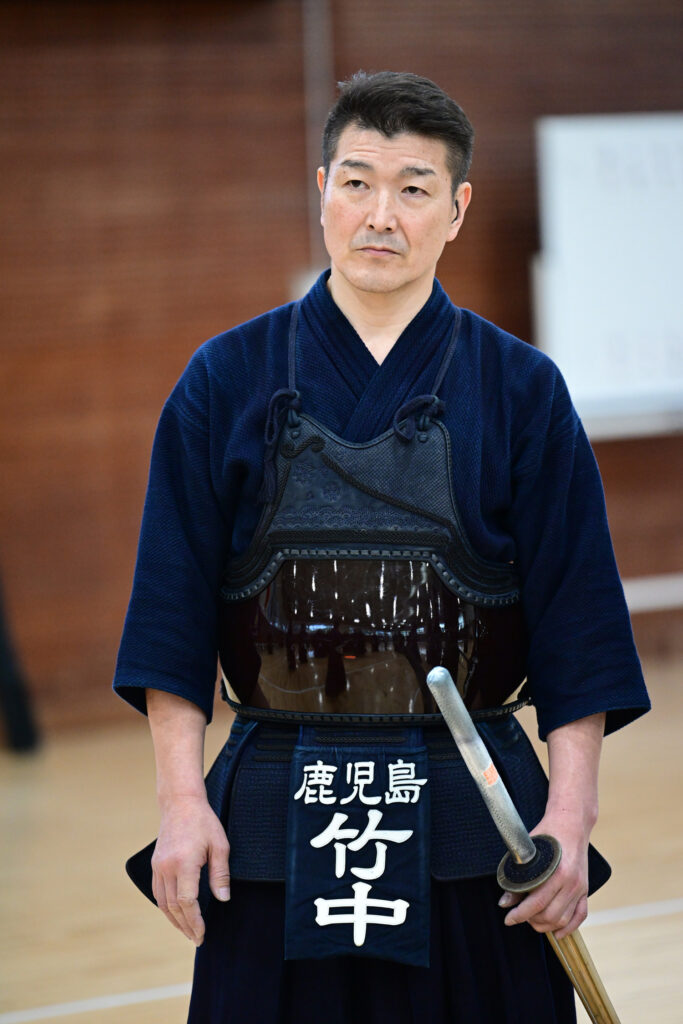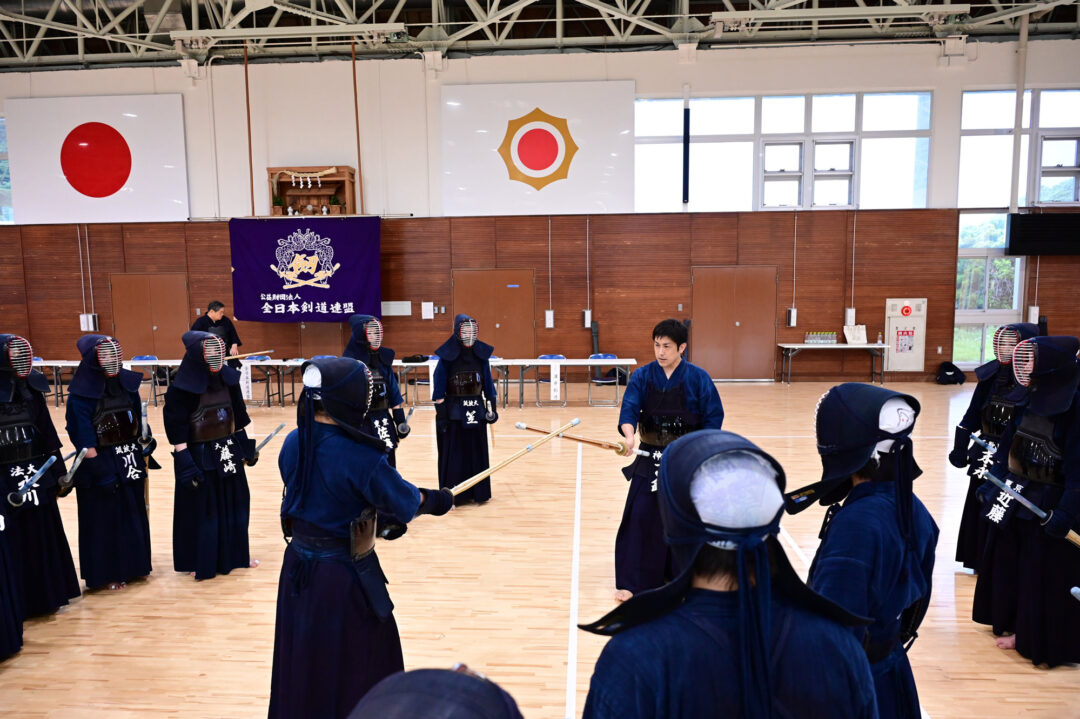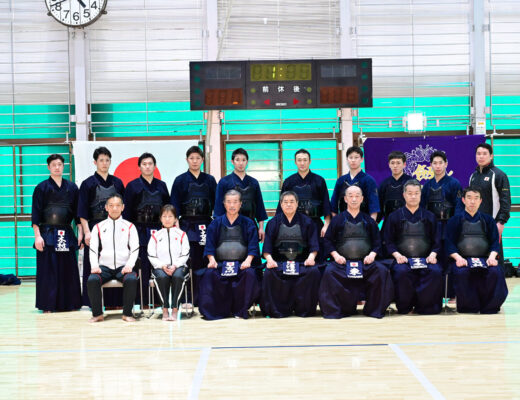2023.9 KENDOJIDAI
Following the men’s representative training camp held earlier this year, the second strengthening training seminar for the women’s team this year took place at the Japan Budokan Training Center in Katsuura, Chiba Prefecture. A battle for the representative spots ensued, featuring a mix of veterans, mid-level, and young competitors. Who will ultimately secure the ten spots to fight for Japan?
Report: Teraoka Tomoyuki
Photography: Nishiguchi Kunihiko
Translation: Jouke van der Woude
Gathering at the Japan Budokan Training Center in Katsuura City, Chiba Prefecture, were 23 female candidates for the Japanese national team. A splendid line-up ranging from veterans to young talents, leaving no one unfamiliar with their names. Each competitor boasts impressive achievements, and the coaching staff undoubtedly faces considerable challenges in selecting the national representatives. The 17th World Kendo Championship (WKC) held in Incheon, South Korea, in 2018 saw the Japanese women’s team achieve flawless victories from the qualifiers to the finals, leaving no room for opponents to seize an advantage. Similar results are anticipated for the upcoming tournament in Italy.
Upon comparing the representatives from the previous event with the candidates for this edition, one significant change stands out. The departure of Matsumoto Mizuki (Kanagawa Prefectural Police), who secured victory in the individual competition and served as the anchor in the team finals, marks a significant transition. While it’s a painful loss to see Matsumoto, who has long been a cornerstone of Japan’s Kendo step back from the representative role, progress has been made since the last WKC. Since then, Watanabe Tai took the role of captain, leading the way for continued progress.
Another significant topic in recent years is the notable return of competitor Suenaga Mari to the representative team. Similar to Matsumoto, Suenaga had withdrawn from the training camps after the previous tournament. However, following her third victory at the All Japan Women’s Kendo Championship last year, she made her comeback as a candidate. She is also driven by a strong determination to participate in the Italy WKC.
Among the 23 candidate competitors, there are eight individuals with prior experience in WKC’s: Suenaga Mari, Watanabe Tai, Takahashi Moeko, Tominaga Hinano, Matsumoto Chika, Takenaka Miho, Komatsu Kana, and Senoo Maika. Additionally, there is a wealth of talent, including competitors like Morooka Atsuko, the winner of the All Japan Women’s Kendo Championship, Kondo Mihiro, the individual champion of the All Japan Police Women’s Individual Kendo Chamionship, and Sato Minori and Onishi Nanami, who have reached the finals in the All Japan Women’s Kendo Championship.
Furthermore, it’s essential not to forget that four university students have also been selected. Led by Mizukawa Haruna, who became student champion in her first and second years, competitors like Kawai Kanna, who secured victory in the recent student championship, and Ryu Hinako and Ogawa Sanae possess capabilities on par with other candidate representatives. Head coach Takenaka Kentaro also seems to hold expectations that young talent will undoubtedly be necessary in the WKC.
During the training camp, Takanabe Susumu, the coach from Kanagawa Prefectural Police who led Japan to victory on the world stage, takes the lead in providing guidance from the ground up on the mindset and techniques required as Japanese representatives. With just one year remaining until the main tournament, regardless of who becomes a representative, they will undoubtedly showcase authentic Kendo on Italian ground.
Women’s head coach Takenaka Kentaro, Kyoshi 8th Dan

–Head coach Takenaka, what kind of competitors do you envision representing Japan and competing in the Italy tournament?
Takenaka: competitors who can take the initiative and create opportunities for themselves to strike. competitors who can’t find openings unless the opponents initiate strikes won’t be able to endure the challenges of a WKC. From applying Seme to executing strikes, I believe that competitors who have the ability to seize a single opportunity are essential for success in WKC’s.
–Until the previous WKC, you were in the role of coach under the guidance of Miyazaki Masahiro Sensei.
Takenaka: I worked with the women’s Japanese national team under the guidance of Miyazaki Sensei for 10 years, learning the intricacies of strengthening. The vision regarding the team and competitors that Miyazaki Sensei cultivated have certainly been passed down to me as well. What distinguishes a WKC from other tournaments is the need to achieve Ippon within the allotted time, whether in individual or team Shiai. While in individual Shiai, one might think that they can win if they avoid being struck, the outcome becomes unpredictable once it enters an extension period. This is precisely why competitors who can secure an ippon within the regular time are crucial. As the environment differs from domestic tournaments, mental fortitude that can adapt to unforeseen circumstances is equally important.
–This is the second training camp in 2023. What aspects do you believe the competitors should focus on during this camp?
Takenaka: I believe that each individual has their own style in Kendo. While our leadership provides guidance on what is expected in a WKC, it ultimately depends on how the competitors interpret it. Of course, without achieving results in this camp, the path to becoming a representative of Japan won’t become clear. Therefore, competitors who can strike a balance within this context are the ones who can truly demonstrate their strength on the WKC stage.
–Observing the candidate competitors, it seems that there are quite a number of young talents.
Takenaka: While the experience and stability of veterans are undoubtedly important, without the emergence of new talents, it’s impossible to compete in WKC’s. The energy of the young competitors invigorates the training camp, and the veterans work hard not to be overshadowed by this enthusiasm. As a result, both sides raise their levels, leading to a positive synergistic effect.
–Could you share your assessment of the veteran competitors?
Takenaka: In terms of overall strength, the veteran competitors are indeed dependable. Suenaga Mari, Watanabe Tai, and Takahashi Moeko. These three competitors form the pillars of the training camp. In women’s Kendo, there are formidable competitors across different age groups, and to fight with strong teamwork, it’s essential for each individual to play their role in their respective positions. A well-balanced team composition that includes both experienced competitors and new forces is ideal.
–Considering your coaching experience, how do you perceive the challenges of a WKC?
Takenaka: Women’s Kendo is not as straightforward as it might seem. In fact, during the WKC in Japan, the only competitor who defeated the Korean competitor who came in second place individually was Matsumoto Mizuki. The other Japanese team members lost to that Korean competitor. In the team competition, Takahashi Moeko had drawn against her. This competitor wasn’t even part of the previous WKC. If we can expect her to appear as the captain in Italy, we need to be prepared for a tough Shiai. I believe that victory becomes viable only when Japanese competitors can unleash a performance that is close to 100% of their potential. Hence, we intend to focus on refining our Keiko during the remaining period.
–What kind of Kendo would you like to showcase to the world’s Kenshi at the WKC?
Takenaka: Due to the changes in the operation of referee rules brought about by the spread of COVID-19, there’s no doubt that the quality of Kendo is now more in demand than ever before. We must demonstrate a form of Kendo on the global stage that contributes to this demand.
–Considering the various types of Kendo practiced worldwide, it seems quite challenging to rely solely on a conventional style, correct?
The rest of this article is only available for Kendo Jidai International subscribers!





